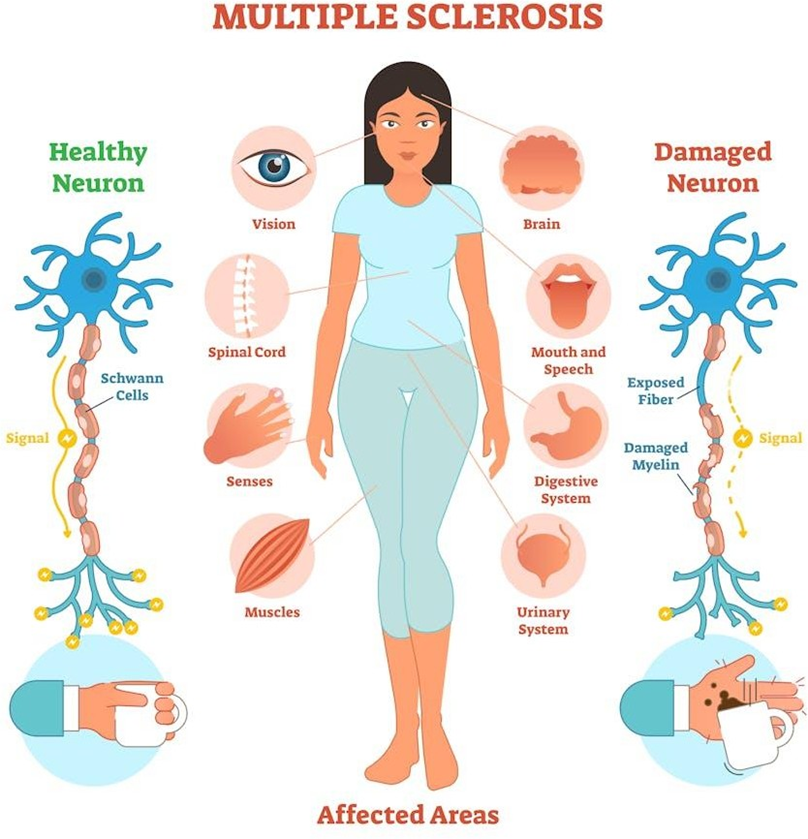What action should the nurse include in completing a health history and physical assessment for a 36-yr-old female patient with possible multiple sclerosis (MS)?
Assess for the presence of chest pain.
Inquire about urinary tract problems.
Inspect the skin for rashes or discoloration.
Ask the patient about any increase in libido.
The Correct Answer is B
A. Assess for the presence of chest pain: While chest pain should always be assessed in a comprehensive health history and physical examination, it is not specifically related to multiple sclerosis unless there are concurrent cardiac issues.
B. Inquire about urinary tract problems: Urinary symptoms such as urinary urgency, frequency, hesitancy, or incontinence are common in multiple sclerosis due to neurogenic bladder dysfunction. Therefore, it is essential to inquire about these symptoms to assess the extent of neurological involvement and provide appropriate management.

C. Inspect the skin for rashes or discoloration: While skin manifestations can occur in multiple sclerosis, they are less common and not typically primary concerns during initial assessment. However, if the patient reports skin changes, they should be evaluated accordingly.
D. Ask the patient about any increase in libido: Changes in libido are not typically associated with multiple sclerosis unless they are related to psychological or emotional factors. While sexual dysfunction can occur in MS, it is not the primary focus during the initial assessment unless the patient presents with related concerns.
Nursing Test Bank
Naxlex Comprehensive Predictor Exams
Related Questions
Correct Answer is A
Explanation
A. BP 190/84, HR 50, and an irregular respiratory pattern is characteristic of Cushing's triad, a classic sign of increased intracranial pressure (ICP). Cushing's triad includes hypertension with a widened pulse pressure, bradycardia, and irregular or abnormal respirations. The elevated blood pressure occurs as a compensatory mechanism to maintain cerebral perfusion, while bradycardia and irregular respirations result from brainstem compression.
B. BP 190/84, HR 150, and an irregular respiratory pattern is incorrect because tachycardia (HR 150) is not part of Cushing's triad. Increased ICP typically causes bradycardia due to brainstem involvement.
C. BP 80/50, HR 50, and Kussmaul respirations: Kussmaul respirations are deep, rapid respirations commonly seen in metabolic acidosis, not typically associated with increased intracranial pressure.
D. BP 80/50, HR 150, and Cheyne-Stokes respirations: Cheyne-Stokes respirations are characterized by alternating periods of deep breathing followed by apnea and are often seen in conditions affecting the brainstem, but they are not specific to increased intracranial pressure.
Correct Answer is B
Explanation
A. Remove clothing: While removing clothing may be necessary for a thorough assessment and treatment, maintaining cervical spine precaution takes precedence to prevent potential spinal cord injury in clients with a history of trauma, such as a fall from a significant height.
B. Maintain cervical spine precaution: Maintaining cervical spine precaution by stabilizing the cervical spine and immobilizing the neck is crucial to prevent further injury to the spinal cord in clients with a history of trauma until spinal injury is ruled out or managed.
C. Perform a mental status exam: While assessing the client's mental status is important for evaluating neurological function, it is not the first priority in a client with potential spinal cord injury following a fall.
D. Assess for facial lacerations: Assessing for facial lacerations is important for identifying and managing potential facial injuries, but it is not the first priority in the primary assessment of a client with a history of trauma and potential spinal cord injury.
Whether you are a student looking to ace your exams or a practicing nurse seeking to enhance your expertise , our nursing education contents will empower you with the confidence and competence to make a difference in the lives of patients and become a respected leader in the healthcare field.
Visit Naxlex, invest in your future and unlock endless possibilities with our unparalleled nursing education contents today
Report Wrong Answer on the Current Question
Do you disagree with the answer? If yes, what is your expected answer? Explain.
Kindly be descriptive with the issue you are facing.
